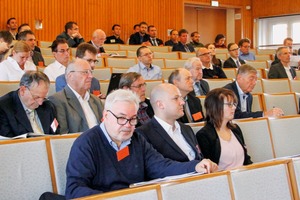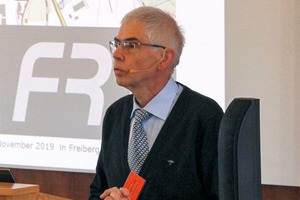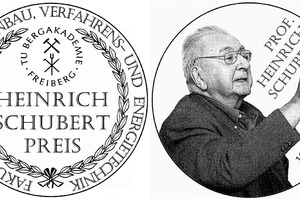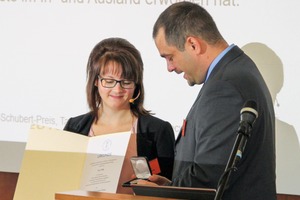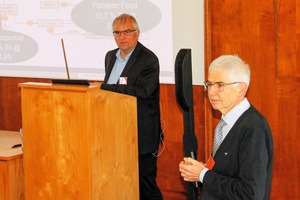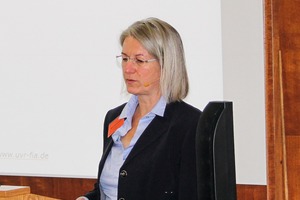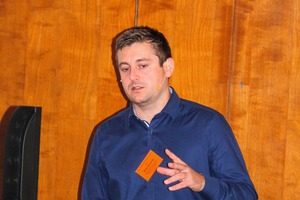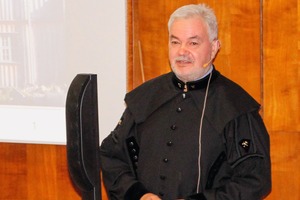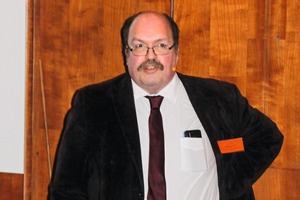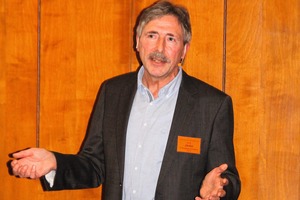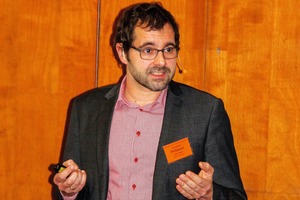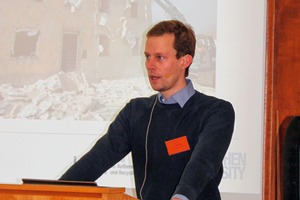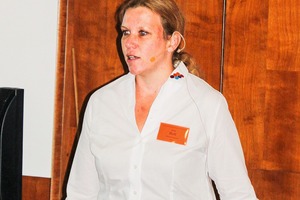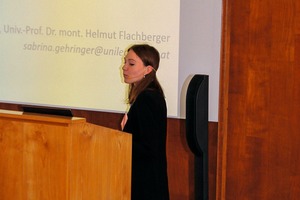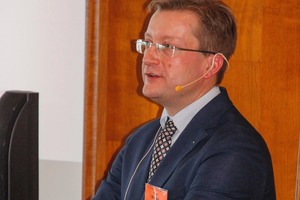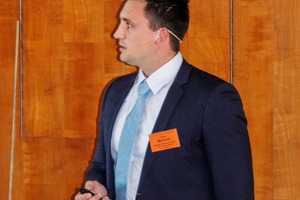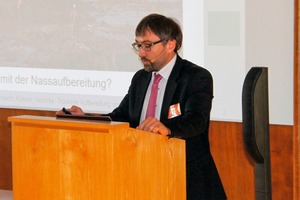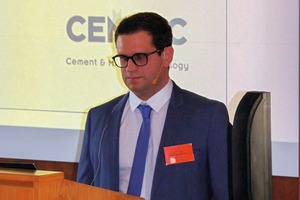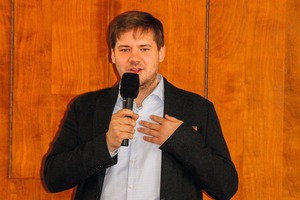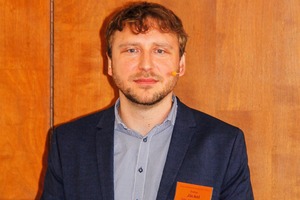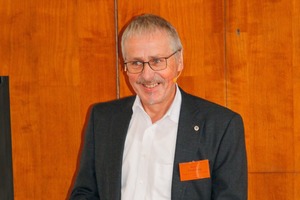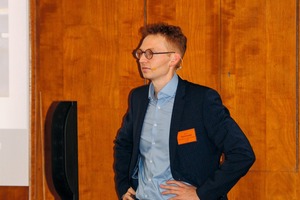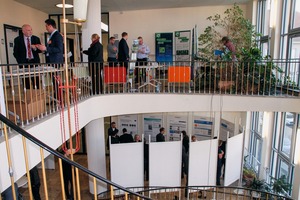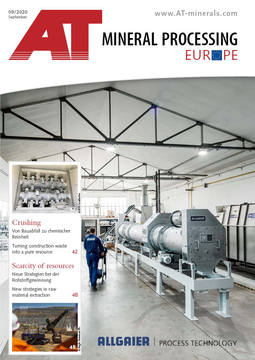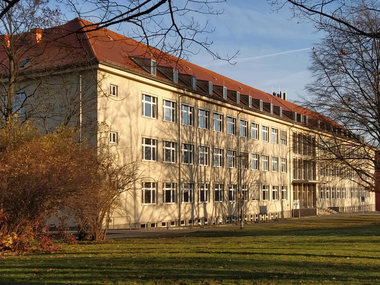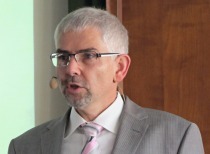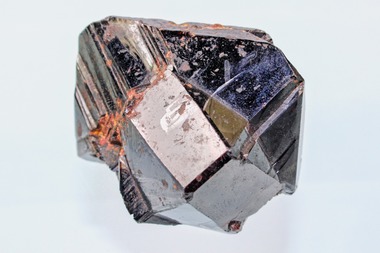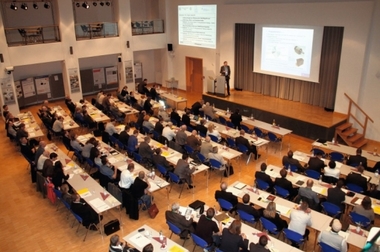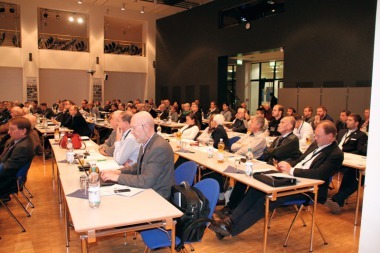Mineral Processing and Recycling – 7 and 8 November 2019 in Freiberg, Part 1
Dr Henning Morgenroth, one of the managing directors at UVR-FIA GmbH opened the conference, and gave an insight into the company’s current areas of work. These include analysis work for material and process characterization, services with the use of wide-ranging machine technology, development and trialling of processes for the processing of raw materials as well as selected publicly funded research projects.
For the first time at the conference, Prof. Dr Tobias Fieback, Dean of the Faculty of Mechanical Engineering, Process and Energy Engineering at Freiberg University of Mining and Technology, presented the Heinrich Schubert Award. This award commemorates the work of Prof. Heinrich Schubert, the former holder of chair who died in 2018. He made outstanding contributions to the fields of mineral processing and mechanical process engineering both in Germany and internationally. The Heinrich Schubert Award is to be presented to individuals who have demonstrated their excellence in one of the above-mentioned fields within the scope of student work (Bachelor-, Master- or Diploma thesis) or in a doctorate. The Heinrich-Schubert Award will in future be presented once a year.
The award winner in 2019 is Lisa Hille, who with her dissertation on “Filtration of metal melts” within the scope of Collaborative Research Centre SFB 920 has delivered an excellent achievement. Objective of SFB 920 is the enhancement of filters for metal melts to improve the quality of the resulting aluminium and steel components. With the help of ceramic foam filters, non-metallic inclusions can be removed from the metal melt. In model tests on systems with water as fluid and alumina foam filters as well as Al2O3, cork and Si-wafer particles, it could be proven that the roughness and hydrophobia of the filters are crucial for the success of the filtration process. The hydrophobic particles and hydrophobic filters were used because, on account of their poor wetting by water, these show similar behaviour to that of the inclusion particles in the melt.
Processing of primary resources
Reports on “A pilot plant for the processing of a complex ore from the Hämmerlein/Tellerhäuser deposit” were presented in two papers. The project was financed by the Federal German Ministry of Education and Research (BMBF) collaborative project AFK (Processing of fine-grained indigenous polymetallic complex ores) and the EU project FAME (Flexible and Mobile Economic Processing Technologies) as well as by the company Saxore. Dr Henning Morgenroth, Irina Bremerstein (UVR-FIA GmbH Freiberg) and Dr Marco Roscher (Saxore Bergbau GmbH) first presented the studies on the technology in the planned processing plant. In 2018, in a continuously operating pilot plant, UVR-FIA GmbH investigated the beneficiation of the polymetallic tin skarn ore from the Pöhla deposit. The total sample of 140 t of the ore was first homogenized, comminuted and washed for sensor-based sorting. After primary comminution <1 mm, in continuous tests, circuit grinding in a wet ball mill, magnetic separation, sulphide flotation, hydrocyclone classification, gravity separation in spiral concentrators, desliming and dewatering of the products were investigated. Sorting with sensors, the drying and the selective comminution were performed in cooperation with partners. Recovered by means of flotation was a Zn concentrate with 25 % and Cu content of 1 % and with gravity separation a Sn concentrate with more than 30 % Sn.
Prof. Dr Karl Gerald van den Boogaart, Dr Chris Broadbent, Wardell Armstrong, Marius Kern, Edgar Schach and Tina Schulz (HIF), Dr Mirko Martin, Dzmitry Pashkevich (G.E.O.S. Freiberg), Ben Breuer (RWTH Aachen) and Rui Sousa (National Laboratory of Energy and Geology, Portugal) reported on further findings of the studies. With multistage selective preconcentration of the value-containing paragenesia based on mineralogical criteria, sensor-based sorting and selective comminution, it was possible to obtain a better concentrated ore as feed material for the following processing steps. The largely metal-free tailings can be used as construction material or directly returned to the mine as backfill. The ore was first ground in stages in the plant and, based on the definition of appropriate separation characteristics, divided into different streams of valuable materials in the process steps magnetic separation, flotation and density separation. In this way, tin, zinc, iron, copper, indium and arsenic could be concentrated. Here the model-based process development showed that there is further potential for optimization of the pilot plant.
“Studies on the separation of tailings in spiral concentrators” was the title of the paper presented by Irina Bremerstein and Dr Henning Morgenroth (UVR-FIA GmbH). Here, results of the sorting of an ore containing magnetite, cassiterite and sulphide minerals by means of spiral concentrators were presented, the objective being the concentration of the valuable minerals by means of the primary separation of the tailings. The studies were conducted on ore samples from Saxony’s Ore Mountains as part of an r4 project funded by the BMBF (AFK New Strategies for Processing Complex Ores from Indigenous Deposits). Starting material was a sample with 1 % Sn, varied were the volume flow rate and solids content. A concentrate with up to 1.4 % Sn, middling products with around 0.4 % Sn and tailings with 0.6 % Sn could be recovered. As fine product with a relatively high Sn content ends up in the tailings, the inadequate suitability of the spiral concentrator could be established. UVR-FIA GmbH conducted studies on these ores concerning comminution behaviour, magnetic separation, density sorting and flotation. The results were incorporated in the planning of a pilot plant for the processing of a large sample of around 120 t of this ore, which was built and operated at UVR-FIA GmbH in 2018.
The paper presented by Kai Bachmann (HIF/Erzlabor-Advanced Solutions GmbH), Dr Deshenthree Chetty (MINTEK), Dr Raimon Tolosana-Delgado and Prof. Dr Jens Gutzmer (HIF) “The impact of mineralogy on processing for recovery of chromite and PGE in the Bushveld Complex, South Africa” addressed the possibilities for the recovery of chromite as well as elements in the platinum group and base metals (Ni, Cu) as by-products. For these studies a non-weathered material was used. Only a very small amount of the economically significant 3E (Pt, Pd, Rh) is included in chromite and the 6E contents (Pt, Pd, Rh, Ru, Ir and Au) of the extracted chromitites normally lie under 2 g/t. More than 100 different diamond cores were used as sample material and characterized with automated scanning-electron-based image analysis. Seven mineralogically different clusters were prepared for subsequent metallurgical evaluation at MINTEK. The samples were ground and gravimetrically sorted and floated in different stages. The results of the analysis of the feed material show for the gravimetric sorting relatively homogeneous contents of the Class 3E in the range from 0.43 to 0.69 ppm, while chromium oxide concentrations show greater variability in the range from 35 to 42 wt%. The feed content for the flotation ranges from 0.75 to 1.96 ppm. Cleaned flotation concentrates show values between around 4 ppm and 16 ppm. The total yield of 3E lies between 25 % and over 40 %. To further increase the yield, a new flotation technology with higher shear forces has to be used for better cleaning of the mineral surface (e.g. Mach reactor) and flotation of liberated platinum group metals.
At the conference, Uwe Bruder (Bruder Consult Hirschau) presented in a paper entitled “Historical processing in the Schneeberg Wolfgangmaßen mine” an insight into the history of mineral processing. 200 years ago economic considerations led to the building of a stamp mill at Wolfgangmaßen mine, one of the most important suppliers of cobalt and bismuth across Europe. At the present time, processing in the stamp mill is being reconstructed faithfully after the historical example to enable understanding of the former technologies. Besides the historical equipment, some modern processing machines are on display, with some being demonstrated in action. The Wolfgangmaßen mine is part of the new world cultural heritage “Mining cultural landscape Erzgebirge/Krušnohoří”. The equipment can be viewed on appointment (Volkmar Müller: Tel. +49 (0)162-4359 984 or Karsten Georgi: Tel. +49 (0) 172-3628 040).
Processing secondary resources/recycling
Dr Ilya Nekhamin, Guido Wähner, Gerhard Nimmerfall, Gerd Schmerler and Dr Rainer Wegner (ReMetall Deutschland AG) informed about the “Pyrometallurgical recovery of precious metals from spent catalysts, use of the slag”. The process was developed as an ideal solution for decentralized precious metal recycling. The aggregates for the materials produced are calculated based on elementary analysis, mixed into the material and pressed to briquets. Then the melt is prepared in batches in a dc arc furnace until a sufficiently large and adequately concentrated collector metal fraction (e.g. 9 % precious metal content). From the still liquid slag, a sample is taken and tested in the company’s laboratory for its possible precious metal content. If no precious metals can be detected, the slag is released for disposal or reuse. Iron is always used as the collector metal. As no environmentally damaging materials are washed out, the slag can generally be used as a substitute construction material, abrasive or, after foaming, as a catalyst substrate.
Dr Hans-Georg Jäckel (IAM) and Matthias Walch (Lars Walch GmbH Baudenbach) reported on possibilities for “Recovery of FeNdB magnets from wind power turbines”. In the forthcoming years, a large share of older wind turbines will be decommissioned because their financial support/subsidies run out after 20 years. A particular problem is the collection and recovery of the RE magnets (FeNdB) from the gearless synchronous generators made by certain wind turbine manufacturers. Despite the high content of valuable metals for neodymium (around 60 €/kg) and dysprosium (around 380 €/kg), these will be lost in a knowingly uncontrolled process from the economic cycle. Starting from the analysis of the overall situation with regard to the decommissioning of older wind turbines, a new project for the recovery of FeNdB magnets with 25 to 30 % Nd and 2 to 6 % Dy from wind turbines was presented in the paper.
“Recycling of rare earths from waste electric and electronic equipment with selective concentration at indigenous clay mineral resources” was the paper presented by Prof. Dr Ralf Diedel (Stephan Schmidt KG), Dr Christoph Piribauer (FGK GmbH) and Prof. Dr Joachim Scholz (University of Koblenz-Landau). In Europe, less than 1 % of rare earths (RE) from WEEE are so far recycled as no separation of components with RE (exception: Nd magnets) is performed. In pyrometallurgical processing, the RE end up in the slags, for which there is no process for RE recovery as yet. An alternative to pyrometallurgy is hydrometallurgy with dissolution of the WEEE in acids and recovery of the RE from the solution by means of adsorption. As adsorber material was in the research project funded by the “BMBF funding pool SME Innovative” clay minerals were used as adsorber material for the first time as an alternative to ion exchange resins. These have a selective effect and adsorb the trivalent lanthanoids preferably over the mono- or bivalent ions of the alkalis and earth alkalis. The developed concept can be basically integrated in a hydrometallurgical process for recycling WEEE. Westerwald bentonites, which are available in large quantities in the overburden of ceramic clays, gave the best results as an adsorber in a screening in comparison with 43 other mineral resources. As the next step planned is the implementation of the process with companies involved in WEEE recycling and/or companies in the field of hydrometallurgy.
“Studies on mechanical preconcentration as a process step for material recycling of thermal insulation composite systems (TICS)” were presented by Martin Simons and Dr Alexander Feil (Department of Processing and Recycling, RWTH University of Aachen). TICS consist of various layers, the insulation as the largest layer in terms of volume is fixed to the wall with adhesive mortar. In Germany, up to this day, already more than 900 million m² TICS have been installed, and every year another 40 million m² are added. On account of the long lifetime of 25 to 60 years, the TICS waste has only increased in the last few years. Focus of the paper was the mechanical preconditioning of TICS to enable material recycling of the individual components with constant quality of the recycling product. The breakdown of the composite and liberation of the valuable material with an appropriate comminution process are necessary, the relationship between the achieved liberation and the required sorting effort playing an important role. Higher liberation is often associated with a stronger reduction in the upper grain size. At the same time, the specific sorting requirement increases for the resulting particles decreasing in size. The test specimens were processed in various comminution machines, screened and sorted by means of air separation. To quantify the results, different indicators such as valuable material and mass yield were used.
Part 2 of the proceeedings will be followed in the next issue of AT MINERAL PROCESSING.
Prof. Dr. rer. nat. habil. Hanspeter Heegn
Gesellschaft für Verfahrenstechnik UVR-FIA e.V. Freiberg

